Published
on 8
Apr 2020
|
All rights reserved.
|
|
|
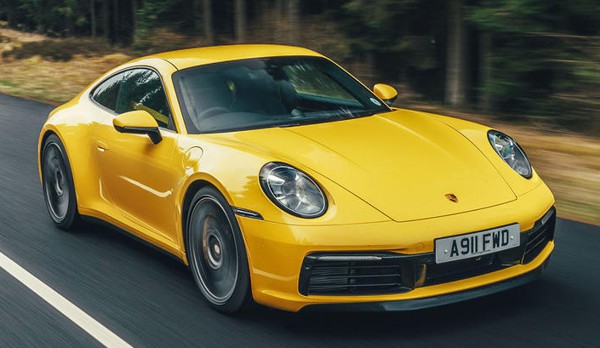
|
|
If
there was another sports car that is just as versatile, we have yet to
meet.
|
|
A new generation 911 has
always been a big news to the automotive world, yet ridiculously, the
changes involved have always been subtle. However, subtle does not mean
any less progress than other cars. While other cars opt to change
styling from one direction to another, alter mechanical layouts from
one kind to another, Porsche rarely deviates from the path it knows
working well. While other manufacturers pendulate from one end to
another end in pursuit of the right formula, Porsche keeps pointing
straight, progresses consistently without wasting any time and efforts.
Judging from the outcome – how great the 911 in every generation drove
– you cannot argue about its vision. For so many years, the 911 is
still the definitive 2+2 sports car that everybody else dreams to beat.
Following type 911, 930, 964, 993, 996, 997 and 991, 992 arrives as the
8th generation 911. At the first glance, the changes are rather subtle
again, but don’t think it as an easy job. Dig under the skin, you will
find most things have been changed. Even if you observe only from
outside, good eyes can see some noticeable differences that mark
improving functions.
The discernible difference is a wider stance. The front of the car is
noticeably wider. It gains 45mm across the front fenders. This is not
achieved by flaring out the fenders, but the bumper is also made wider.
It implies the intent is not only to widen the track for better
handling, but also to provide a larger frontal area for bigger cooling
intakes and more volume under the front bonnet to accommodate the
battery cooling system and power electronics in the upcoming hybrid
version. Yes, the 992 will be the first 911 accommodating hybrid power,
although it is not expected to be ready for launch until the mid-cycle
refresh.
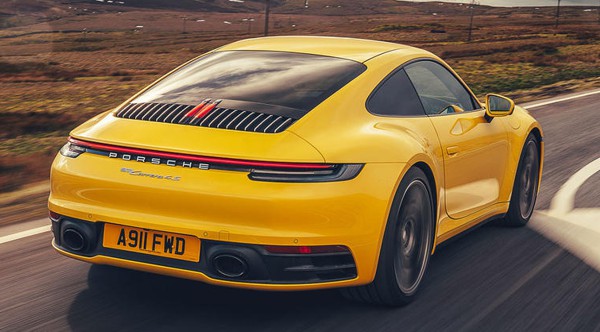
|
|
Wide
body is now standard, as is a bigger bum.
|
|
The
hybrid call also results in a bigger bum. Over the years, the 911’s
sloping ducktail has been raising constantly, especially in the
991-series. Now it is even higher and bulkier, chiefly to make room for
the hybrid system’s electric motor and its cooling. Moreover, the
Carrera and Carrera S no longer sport a narrower body. Both of them
use the 1852mm-wide body previously reserved for the 4S and GT3 models.
As a result, the front and rear track are widened by 46mm and 39mm,
respectively. As we shall see, this improves the car’s handling.
Even compared with the outgoing 4S, the rear fenders on the 992 seem to
flare out more dramatically. This is because the rear wheels have been
enlarged from 20 to 21-inch (thus larger than the front wheels for the
first time) in order to enhance traction and grip, so the larger wheel
arches get closer to the rear quarter windows, hence the need to curve
the fenders more dramatically.
In terms of styling, the team of Michael Mauer has done a decent job to
envelop the less perfect proportion, especially the tail which draws on
a retro theme with vertical grille elements. The ultra-slim taillights
and an LED light stripe bridging between them look stylish. Up front,
style is somewhat compromised with functions, as the larger and squarer
intakes look less harmonious, especially when compared with the early
991 whose nose was particularly stylish. The square-off bonnet is also
a step backward in style.
The 992 keeps the same wheelbase of its predecessor, but overall length
is extended by 20mm, all spent at the nose to improve crash safety.
Drag coefficient of the body is unchanged at 0.29, thanks partly to
variable flaps at the intakes, but the wider body means the overall
drag increases slightly. Downforce is improved by making the
retractable rear spoiler wider and 45 percent larger, and now it raises
to 2 angles depending on speed.
|
|
|
Aluminum
content is lifted to 70 percent, yet the car is 50kg heavier.
|
|
Let’s turn to the invisible parts. The monocoque
construction of 992 is still a hybrid of steel and aluminum, but the
balance shifts from the former to the latter. Aluminum content is
lifted from 37 to 70 percent, while chassis rigidity is improved by 5
percent. While the 991 still employed a few steel panels, the 992 has
all its outer skin made of aluminum. Theoretically, the body should be
lighter than before. However, due to the extra dimensions, strengthened
powertrain, upgraded equipment and all the designs prepared for hybrid
power – one of which is the new PDK transmission which can handle 590
lbft of torque, far exceeding the need of the Carrera S or even the
upcoming GTS – the 992 is 50kg heavier than its
direct predecessor. Now even the basic Carrera tips the scale at over
1500kg. If you compare it with the naturally aspirated 991
that debuted in 2011, it is even a full 100kg heavier. In addition to
the wider body, this is not a good news.
However, the latest version of 3.0 twin-turbo flat-six motor, codenamed
9A2 Evo, is more powerful again. Output of the Carrera S is lifted from
420 to 450 horsepower. 33 years ago, we thought 450hp was a magic
number on the 959. Now it is available to a standard 911. Maximum
torque is improved from 369 to 391 lbft, released at 2300-5000 rpm.
This enables the Carrera S to improve 0-60 mph by 0.3s to 3.4 seconds,
and 0-100mph is achieved in 7.8 seconds. Such performance matches an
Aston Martin Vantage, which is more powerful but also heavier. The
cheaper Carrera model gains less performance though. Horsepower is
improved by merely 15 to 385 while peak torque remains unchanged at
332. Still, it is able to cut 0-60 in 3.9 seconds, a tenth quicker than
before.
While the basic cylinder head, block and internals are unchanged, the
new motor is enhanced with piezo injectors (faster and higher
pressure), a higher compression ratio (10.2:1 instead of 10.0:1) and a
redesigned VarioCam Plus system that allows one intake valve to open
deeper than another under partial load, creating swirl and improving
fuel-air mixing. In addition to the adoption of gasoline particulate
filters, the 9A2 Evo is cleaner and more efficient. The turbochargers
get larger, running a maximum 1.2 bar on the Carrera S instead of 1.1
bar on the old model (Carrera gets smaller turbos and its boost
pressure stays at 0.9 bar, as evident from its unchanged torque
figure). Moreover, the two turbos are no longer identical parts, but
made symmetrical, so that their ducting are equal length and shape,
ensuring the same breathing efficiency. The intercoolers are not only
12 percent larger but have been moved from the sides of the engine to
the top, directly under the engine vents, taking advantage of the
cooling air flow. Lastly, the engine is now mounted to the frame at the
cylinder heads instead of crankcase, providing a stiffer base hence
less shake and vibration under throttle.
|
|
|
The
engine gets more powerful yet more responsive, but trademark exhaust
note is toned down.
|
|
The 992
debuts with PDK gearbox only, although a 7-speed manual will join later
this year. The new PDK gains an extra ratio to 8, but the last 2 ratios
are actually over-drive to save fuel when cruising. This means top
speed
is reached at 6th. The new gearbox has 4 instead of 2 shafts for a more
compact package, so it may accommodate an electric motor in the future.
Like the PDK, the electronic-controlled 4WD system on Carrera 4 and 4S
can handle stronger torque to the front axle, but otherwise it is just
the same as before. The electric power steering of the outgoing 991 has
nothing wrong – actually the best of its kind, if not as good as
McLaren’s old-fashioned hydraulic rack for feel – but it is geared to
turn 11 percent quicker. 4-wheel steering is again available as an
option to the Carrera S but not the base model.
The suspension basics are kept from the old wide-body cars, but springs
get 15 percent stiffer up front and 14 percent stiffer at the back.
PASM adaptive damping is now standard fitted to both Carrera models.
Moreover, it gets new Bilstein continuously adaptive dampers which
allow broader range of variation and quicker response. In short, more
comfortable than the old PASM when you want to relax, more control when
you want to
attack. For hardcore drivers, there is a PASM Sport suspension option
to Carrera S. It lowers ride height by 10mm while dial up spring rates
18% and 28% front and rear respectively. Another option is active
anti-roll bars, but experience found it is not really necessary.
The 992 keeps its front tire size unchanged. The rear ones are also no
wider than before, which is admittedly already very wide at 305mm, but
growing their diameter from 20 to 21 inches result in larger contact
patches, hence more traction and rear grip. Normally a grippier rear
end could lead to more understeer, but since there are also suspension
changes, Porsche claims the 992 both understeers and oversteers less,
providing a more neutral and precise handling.
Even the traditionally impressive braking has been improved. The rear
brake discs have been enlarged from 330 to 350mm, although they still
fail to fill the 21-inch wheels. Brake servo is changed from vacuum to
electro booster, paving the way for plug-in hybrid power. If you enjoy
track days, you should get the optional ceramic brakes and Sports
Chrono pack, which includes launch control and adaptive engine mounts.
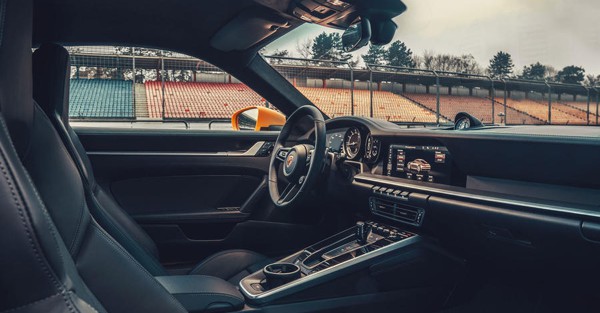 |
|
Suddenly,
the 911 seems to turn from a driving machine to a luxury car.
|
|
Inside,
the driving environment is familiar. Visibility is excellent for a
sports car. The seats and driving position are perfect. All controls
are
found at the right places and offer the right responses. However, the
cabin is now apparently more luxurious, more advanced and higher in
quality. The traditional 5-dial instrument is overhauled, leaving only
the center tachometer, while sandwiching that analogue dial is a pair
of TFT screens. They may display the remaining 4 dials, or the
navigation map, or even the thermal image of NightVision system.
Meanwhile, the center touch screen grows significantly to 10.9-inch and
is mounted higher, above the air vents for easier reading. The graphic
is crisped and interface is well thought out. Under the screen is a row
of piano keys for shortcut functions. All mechanical switches feel
high-quality when touched. The Panamera-style center console has
gloss-black treatment and touch-sensitive buttons with haptic feedback.
Suddenly, the 911 seems to turn from a driving machine to a luxury car.
The only anticlimax is the inclusion of a cup holder at the
transmission tunnel. It might be a practical feature, but looks more
MPV than MVP. There are also more safety and driving assistance, such
as adaptive cruise control, lane keeping assist, automatic emergency
braking, NightVision and 360-degree camera. Fortunately, no
self-parking system to insult its driver.
However, the 992 has not lost its direction when it comes to
driving. If there was another sports car that is just as
versatile – I mean as quick on both road and track, as agile, as
engaging to drive yet as usable, as comfortable, as reliable and as
impeccably built, we have yet to meet. While Porsche has 2 other cars
delighting keen drivers more, i.e. GT3 and GT4, the Carrera and Carrera
S are as good as everyday road cars can get, because they have all the
creature comfort you want, and is less tiring to drive after a day of
hard work. If you can live with 2 seats (forget that +2, which is a
good luggage space nonetheless), and if you can own one and only one
car, I suppose the 911 Carrera S is the car you should have, because it
can satisfy all situations while keep you smiling happier than the
likes of BMW M2 Competition, Nissan GT-R, Audi R8, AMG GT or just about
any Aston Martin at any prices.
For a starter, the boxer motor of the Carrera S is a gem. Its power
delivery is smooth and more linear than you would expect for a
turbocharged engine. Despite bigger turbos, it feels more responsive
than before. It is happy to pull from as low as 2000 rpm and even more
enthusiastic to visit its 7500 rpm limit, just like a naturally
aspirated motor. The PDK gearbox is close to perfect, transmitting its
power smoothly with minimal interruption. Moreover, with superior
traction due to its 36:64 front-to-rear weight distribution, the
Carrera S accelerates from a standstill faster than almost any
rear-wheel drive cars with similar power and fuel efficiency. Even the
much rawer and madder GT3 is just marginally quicker in a straight
line. With good mid-range torque, in-gear acceleration is muscular,
too. This is a well-rounded motor. Its only shortcoming is a slightly
subdued aural character, blame to the particulate filters that have the
911’s trademarked exhaust note toned down. As a result, it doesn’t
sound as exciting as it should be. The AMG V8 on Aston Martin Vantage
or AMG GT sounds more thrilling, while the new 911 steps closer to the
territory of GT.
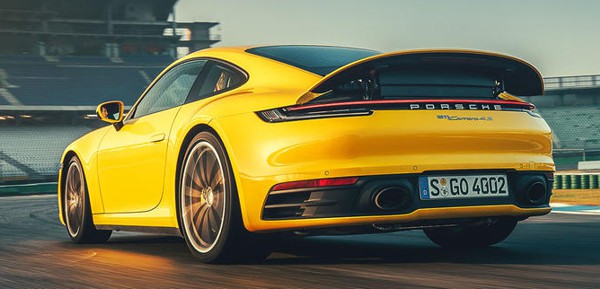 |
|
Thanks
to the widened front track and retuned suspension, its balance is
noticeably more neutral.
|
|
More so
than acceleration, the braking performance is sensational, thanks again
to its rearward weight bias. Not only stopping distance is
outstandingly short, pedal feel is perfect.
The superb braking and powertrain are both expected. What makes the 992
noticeably different from the old car is cornering. Traditionally,
911’s chassis is tuned to understeer when arriving a corner. Back off,
flick the steering, apply counter lock mid-corner will push its tail
out, apply throttle measurably to keep it sliding, and the car exits
corner beautifully. In short, you need to work hard to manage its
balance, living between understeer and oversteer. The outgoing 991 had
this understeer and oversteer largely tamed, but still it was
noticeably more than a good mid-engined car. That is also why we always
prefer the Cayman GT4 to the 911 of any kinds for pure handling. While
this preference still stands today, the 992 has closed the gap again.
Thanks to the widened front track and retuned suspension, its balance
is noticeably more neutral. Its steering gets quicker, more precise and
loaded with feel. The front axle bites harder, refusing to understeer.
The stability and roadholding are lifted to a higher level. The stiffer
springs and more advanced dampers have pitch and roll controlled
tighter than ever, closing the gap from mid-engined machines again. The
suspension is unfazed by undulations, bumps and road camber. It just
steers to where you point, without hesitation, without nervousness.
Should you push beyond its very high limit of grip, you will find an
oversteer which is more subtle. The handling of 992 is not only
stronger and more precise, but it is also more forgiving.
However, on the flipside you may say it has lost some of its character,
because a precision tool is also a less playful one. To exploit
oversteer on public road is made harder by its enhanced neutrality and
higher grip level. This means the emotional link to the traditional
911s gets thinner. The same goes for the aforementioned quieter exhaust
and luxurious cabin. In fact, the 992 gets closer to the territory of
luxury GT. Switch the PASM to normal mode and you will enjoy a supple
ride. With the exception of tire roar, blame to those large rear
wheels, cruising refinement is almost as good as a conventional GT, as
the cabin is better insulated than ever.
What about the basic Carrera? It is not quite as fast as Carrera S, but
no less enjoyable to drive. Its engine is even more lag-free, while the
handling is just as good. This makes its £83,000 asking price
seems more attractive than the £93,000 Carrera S. Meanwhile, the
£98,000 Carrera 4S remains a less purist choice, as the 4WD
system adds 50kg and has the steering and balance corrupted slightly.
Although the Carrera models are not quite as characterful as they used
to be, they are more talented in every objective measure. They are
better sports cars as well as better GTs. If you think they are not
pure enough to inspire excitement, you can always choose a GT3 or GT4
instead. However, for most drivers using their 911s as a daily
transport, the Carrera models are damn near perfect.
|
Verdict:      |
Published
on 25
Sep 2021
|
All rights reserved.
|
|
911 Carrera GTS
|
|
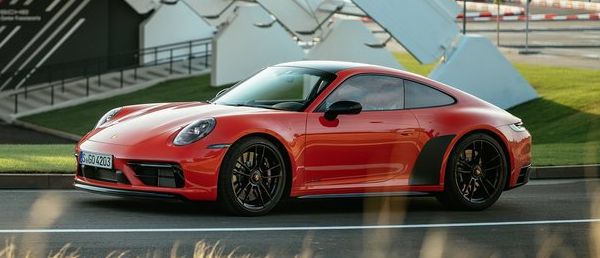
|
|
Do
we really need the GTS? Probably not, but it doesn't hurt to have more
performance, control and noise at no obvious drawbacks.
|
|
Although the GTS badges on
Panamera and Porsche’s SUVs usually mean the sportiest driving
experience, and the one on 718 Boxster / Cayman even means the
resurrection of flat-six power, its role in the 911 range is far less
significant. Usually it was a Carrera S added with performance options
like PASM suspension and Sport Chrono pack as standard, with the engine
tuned to deliver a bit more horsepower, and the biggest change was
adopting the wider body of Carrera 4S. It lived in the narrow space
between the Carrera S and the base Turbo, while GT3 has a significantly
sharper edge to please hardcore drivers. In short, a role not very
clearly defined.
Although Porsche said this time the new 992 Carrera GTS has a more
distinctive character, I am not quite sure. Outside, it has nothing
differing from the Carrera S except color and minor cosmetic tweaks.
All Carrera models now sport wide body, so the GTS is no longer
different. The engine gets an extra 0.15 bar of boost pressure to
realize another 30 hp and 29 lbft, now 480 hp and 420 lbft. You still
get PASM suspension as standard, which sits 10mm lower than non-PASM
cars. The suspension is said to be adapted from the Turbo rather than
uprated from the Carrera S, which is evident in the adoption of helper
springs in the rear suspension for quicker rebound. However, since the
Turbo has a wider body again, I suppose the suspension geometry has to
revert to Carrera-spec. The GTS also runs the same wheels and tire
sizes as the Carrera S, although the lightweight single-nut wheels look
the same as Turbo’s. However, its larger brakes – 408mm and 380mm steel
discs – really comes from Turbo.
Naturally, the GTS is priced between the Carrera S and base Turbo. You
can push it closer to the latter by opting for lightweight package,
which includes carbon-fiber bucket seats, lightweight battery, thinner
glass, the removal of rear seats and, curiously, rear-wheel steering.
This saves 25 kg. Otherwise, the GTS is 30 kg heavier than the Carrera
S. The official performance figures are 193 mph top speed, 0-60 in 3.3
seconds and Nurburguring lap time of 7:25. All improve slightly from
the Carrera S.
On street, the gain in performance and handling is equally subtle. You
need to drive both cars back to back to confirm the improvement in
performance or handling, but bear in mind that the current Carrera S is
already so fast and agile that it makes the Turbo S superfluous, as I
pointed out in the review of the latter. For the same reason, do we
really need the GTS? Probably not, but it doesn't hurt to have more
performance, control and noise at no obvious drawbacks. Moreover, with
reduced sound insulation, the GTS does let more engine noise penetrate
into the cabin. That might answer those complaining the Carrera models
for too refined.
|
Verdict:      |
Published
on 20
Aug 2024
|
All rights reserved.
|
|
911 Carrera GTS (T-Hybrid)
|
|
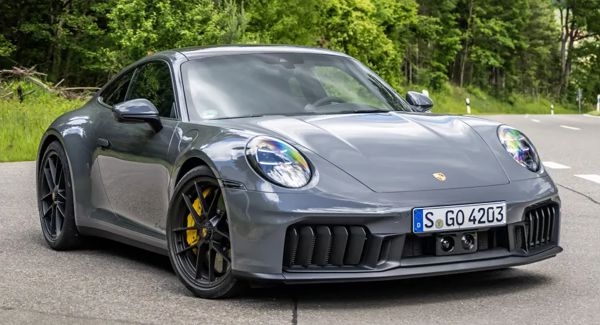
|
|
It
took Porsche 5 years to convince itself that hybrid technology fits for
the 911...
|
|
Time flies. The 992
generation of 911 is almost 5 years on the market, and it is time to
have a mid-cycle refresh. Unofficially called 992.2, the refresh is
very subtle on the base Carrera but far more dramatic for the GTS,
while Carrera S and T will follow later. The base Carrera’s 3-liter
engine gains turbos from the old GTS and intercoolers from the last
Turbo. Still, horsepower is boosted by merely 9, and torque delivery
remains unchanged. No wonder from 60 to 124 mph all acceleration
figures are improved by only a tenth of a second. To the driver, the
biggest change is actually inside: a fully digital instrument display
replaces the old hybrid setup of analogue rev counter and LCDs. It’s a
sad change actually, although you can configure it to display the
classic 5-dial instrument.
When Porsche designed the 992 generation, it was supposed to support
hybrid power, which is evident that the 8-speed PDK transmission
reserves room to fit an electric motor. Somehow, it took Weissach 5
years to figure out how to pack hybrid power without adding too much
weight and handling penalty. The resultant powerplant, called
“T-Hybrid” as T stands for Turbo, makes debut on the new GTS.
Performance figures first: the new GTS lapped Nurburgring in 7:16.9,
some 8.7 sec less than its predecessor. It hits 60 mph from rest in 2.9
seconds, 100 mph in 6.8s and 124 mph in 10.5s, 0.4, 0.8 and 1.1 second
respectively quicker than before. In fact, it is as quick as the
supercars of yesteryears, such as Carrera GT.
Combined output of the hybrid powertrain is 541 hp and 450 lbft, an
increase of 61 hp and 30 lbft over its predecessor.
The entire car weighs 1595 kg DIN, 50 kg heavier than before, which is
rather modest for a hybrid conversion. However, this figure excludes
the rear dog seat, which is now listed as no-cost option as Porsche
needs to eliminate that 10 kg or so to meet its own target of under
1600 kg. Moreover, the high-volt lithium battery is extremely small at
1.9 kWh, so the GTS cannot drive on electric power alone. Neither can
it be charged via plug. It is a conventional hybrid like Toyota Prius.
Style-wise, the biggest change is certainly the louvered intakes at
either side of the front bumper. Those flaps can be closed to reduce
drag when it does not demand so much cooling. Doing so, its drag
coefficient is lowered from the old car’s 0.32 to merely 0.27,
remarkable for a sports car. It goes without saying it is a lot more
slippery than any 911 has ever been.
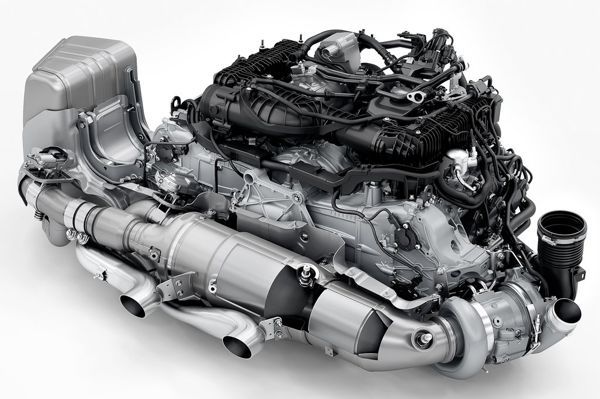
|
|
Gaining
600 cc and switching to a single electric turbo, the engine is actually
the biggest change.
|
|
As aforementioned, the disc-shape electric motor of the hybrid system
is incorporated into the ZF-built 8-speed PDK gearbox. It produces 56
hp and 111 lbft of torque, doubling as starter generator to cut weight.
The small lithium battery weighing 27 kg is mounted above the front
axle, reducing the fuel tank slightly and necessitates to move the 12V
battery under the area used to be rear seats. Inverter and power
control module is placed directly above the boxer engine, which has
been redesigned to be lower.
As seen, the hybrid 911 remains a rear-driver, unlike Lamborghini or
Corvette which use the opportunity of hybridization to introduce
all-wheel drive. However, the GTS can always mate with mechanical
4-wheel drive system when it is called Carrera 4 GTS. Heavier still is
the GTS Targa 4, which is a 1745 kg car, so we’d better to return to
the simplest version.
Surprisingly, the biggest change to the GTS is not the hybrid system
but actually the flat-6 engine. Its capacity is enlarged from 3.0 to
3.6 liters by increasing the bores from 91 to 97mm and lengthening the
stroke from 76.4 to 81mm. Compression ratio is raised slightly to
10.5:1.
Even more surprising is the abandoning of twin-turbo design and reverts
to a single large turbo, something last served the air-cooled 964 Turbo
until 1994. However, like the outgoing VTG turbos, this one is built by
BorgWarner and features state-of-the-art technology: electrical
assistance. A 27 hp electric motor is added between the exhaust turbine
and compressor wheel to help spooling up the turbine quickly, reducing
turbo lag even though the turbo is much larger. It is like the electric
turbo employed by the latest Mercedes SL43 and C63, but goes one step
further: it can recapture exhaust gas energy like the MGU-H motor in
Formula One. When the exhaust turbine produces more boost than the
engine requires, the turbo’s motor acts as a generator, harvesting up
to 15 hp from the hot exhaust stream while slowing down the turbine,
preventing the latter to exceed its 125,000 rpm rev limit. This also
allows the engine to ditch conventional wastegate.
Because of the much improved turbo boost response, Porsche decided to
ditch the long-serving variable valve lift mechanism, i.e. the "Plus"
element of VarioCam Plus. This removes the switchable tappets and
allows the new engine to use rocker arms to reduce friction.
The single turbo is placed at the right side of the engine, so the
exhaust manifolds from the left engine bank is much longer, requiring
some design consideration to balance the gas flow. On the plus side,
the single turbo makes exhaust after-treatment easier, requiring only
one particulate filter, catalytic converter and silencer. The new
exhaust pipes exit from the center of the tail, different from the old
car.
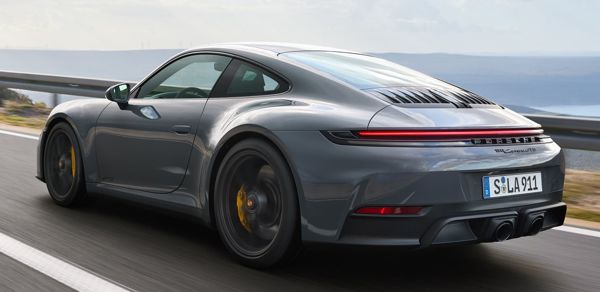
|
|
The
engine feels more urgent, always ready to deliver, accompanied with a
louder and gruffier soundtrack.
|
|
The engine alone produces 485 hp and 420 lbft, just 5 horsepower more
than the outgoing 3.0-liter GTS engine. Surprisingly, it runs higher
boost pressure at 1.8 bar instead of 1.3 bar. This is because Porsche
decided to run an air-fuel mixture ratio of Lambda=1, or 14.7:1,
abandoning the conventional arrangement of using richer mixture at
higher loads in order to clean up emission. It means the hybrid engine
will be future-proofed, capable of dealing with tighter emission
standards, but on the downside is less cooling effect can be achieved
from fuel injection, hence the need to retard ignition at full throttle
and less power can be extracted from a given capacity. Therefore it
needs to enlarge engine capacity and run a higher boost pressure. Fuel
consumption figures are not much different from the old car though, so
the
T-Hybrid technology is more a performance upgrade than a means to boost
fuel efficiency.
To cope with increased power, the GTS employs 10mm wider rear rubbers
while rear-wheel steering is made standard. Needless to say, the
suspension and electronics are all recalibrated to suit the extra
weight and power.
On the road, the new power unit adds another dimension to the car’s
driving experience. The electric motor might not be too powerful, but
the instant torque it produces at lower revs kills turbo lag and speeds
up engine response significantly – Porsche said it takes just 0.8
second to reach full boost instead of the previous 3 seconds. This
means the engine feels more urgent, always ready to deliver,
accompanied with a louder and gruffier soundtrack. Keep pushing, the
GTS feels almost as quick as a Turbo, rendering the latter superfluous.
Best of all, the hybrid system works invisibly behind the scenes. Its
engagement and disengagement is so seamless that you won’t sense at
all, just feel the remarkable response and power like a much larger
naturally aspirated engine.
In corners, the almost instantaneous throttle response benefits
handling, too. There is no turbo lag to consider in corner entry, nor
any rush of power at corner exit. You can commit more to the corner,
balancing the car on throttle more fluidly.
Granted, with more weight and wider tires than ever, the GTS needs
rear-wheel steering to keep its agility, and sometimes that could feel
unnatural. Higher performance
notwithstanding, it is not necessarily more fun to drive than the basic
Carrera. The Carrera is now a £100K car before options, and the
GTS is a third dearer again. Porsche’s core sports car has become a
luxurious product, no longer the pure driving machine in the air-cooled
era.
|
Verdict:     |
|